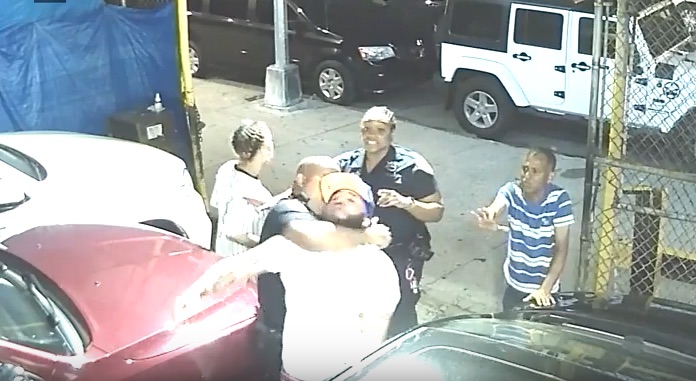[legal system based on coercion, violence] Video Shows Lawless NYPD Cop Using Chokehold to En-Force Noise Ordinance on Unarmed Latino Man
/An NYPD cop who has been sued multiple times for using excessive force placed a Latino man in a chokehold and then shot him with a Taser gun last month while responding to a noise complaint. According to a criminal complaint, 33-year-old Tomas Medina was outside a car dealership at 438 West 206th Street around midnight on July 14th when Detective Fabio Nunez and Officer Shanee Pierce responded to a complaint of loud music. “They told me the neighbors complained about the music,” Medina told the Daily News, which first reported the story. “I told him I was already picking everything up to go.” At around the 11:39 mark in the video below, which was provided by Medina's attorneys at the Legal Aid Society, Detective Nunez approaches Medina from behind, grabs him by the neck, and pushes him into the side of a car. [MORE]
"Lawless Society - a socio-juristic human relation confliguration where law is upheld, codified, and deified over humanity. If you fear or worry about its advent, you'll certainly never recognize its presence. 2) a Police State of the Overruling Class" - from FUNKTIONARY. Dr. Blynd states, "the difference between an outlaw and a lawman is mainly on paper - not on principle."
Michael Huemer further explains,
"The Significance of Coercion and the Reach of Authority
The need for an account of political legitimacy arises from the moral significance of coercion and from the coercive nature of government. It is important to bring these principles clearly into focus, to have a clear view of what needs explaining before we try to explain it.
First, what is coercion? Hereinafter, I use the term ‘coercion’ to denote a person’s use of or threat to use physical force against another person. When I speak of coercing a person to do something, I shall mean using physical force or the threat of physical force to induce that person to perform the desired action. I use ‘physical force’ and ‘violence’ interchangeably. I shall not define ‘physical force’ here; our intuitive understanding of the notion will suffice for the subsequent arguments, and I shall not rely on any controversial judgments about what qualifies as physical force.
My definition of ‘coercion’ is not intended as an analysis of the term’s standard use in English. It is a stipulative definition, intended to avoid repetition of the phrase ‘use of or threat to use physical force’. My use of the term differs from the ordinary usage in at least two ways: first, in the ordinary sense of the term, when A ‘coerces’ B, A induces B to behave in some way desired by A; but in my sense, A might coerce B by physically injuring B, whether or not A influences B’s behavior. Second, the ordinary sense counts a broader range of threats as coercive: in the ordinary sense, A might ‘coerce’ B using a threat to spread malicious rumors about B. This would not qualify as coercion in my sense, because the threat is not one of violence. The ordinary concept of coercion is useful in many contexts; nevertheless, I have introduced a stipulative definition because doing so enables us to consider some important and interesting arguments regarding political authority, while avoiding unnecessary semantic debates.
Government is a coercive institution. Generally speaking, when the state makes a law, the law carries with it a punishment to be imposed upon violators. It is possible to have a law with no specified punishment for violation, but all actual governments attach punishments to nearly all laws. Not everyone who breaks the law will in fact be punished, but the state will generally make a reasonable effort at punishing violators and will generally punish a fair number of them, typically with fines or imprisonment. These punishments are intended to harm lawbreakers, and they generally succeed in doing so.
Direct physical violence is rarely used as a punishment. Nevertheless, violence plays a crucial role in the system, because without the threat of violence, lawbreakers could simply choose not to suffer punishment. For example, the government commands that drivers stop before all red lights. If you violate this rule, you might be punished with a $200 fine. But this is simply another command. If you didn’t obey the command to stop before all red lights, why would you obey the command to pay $200 to the government? Perhaps the second command will be enforced by a third command: the government may threaten to revoke your driver’s license if you do not pay the fine. In other words, they may command you to stop driving. But if you violated the first two commands, why would you follow the third? Well, the command to stop driving may be enforced by a threat of imprisonment if you continue to drive without a license. As these examples illustrate, commands are often enforced with threats to issue further commands, yet that cannot be all there is to it. At the end of the chain must come a threat that the violator literally cannot defy. The system as a whole must be anchored by a non-voluntary intervention, a harm that the state can impose regardless of the individual’s choices.
That anchor is provided by physical force. Even the threat of imprisonment requires enforcement: how can the state ensure that the criminal goes to the prison? The answer lies in coercion, involving actual or threatened bodily injury, or at a minimum, physical pushing or pulling of the individual’s body to the location of imprisonment. This is the final intervention that the individual cannot choose to defy. One can choose not to pay a fine, one can choose to drive without a license, and one can even choose not to walk to a police car to be taken away. But one cannot choose not to be subjected to physical force if the agents of the state decide to impose it.
Thus, the legal system is founded on intentional, harmful coercion. To justify a law, one must justify imposition of that law on the population through a threat of harm, including the coercive imposition of actual harm on those who are caught violating the law. In common sense morality, the threat or actual coercive imposition of harm is normally wrong. This is not to say that it cannot be justified; it is only to say that coercion requires a justification. This may be because of the way in which coercion disrespects persons, seeking to bypass their reason and manipulate them through fear, or the way in which it seems to deny the autonomy and equality of other persons.
I shall not attempt any comprehensive account of when coercion is justified. I rely on the intuitive judgment that harmful coercion requires a justification, as well as some intuitions about particular conditions that do or do not constitute satisfactory justifications. For instance, one legitimate justification is self-defense or defense of innocent third parties: one may harmfully coerce another person, if doing so is necessary to prevent that person from wrongfully harming someone else. Another justification for harmful coercion is consent. Thus, if you are in a boxing match, to which both participants have agreed, then you may punch your opponent in the face.
On the other hand, many possible reasons for coercion are clearly inadequate. If you have a friend who eats too many potato chips, you may try to convince him to give them up. But if he won’t listen, you may not force him to stop. If you admire your neighbor’s car, you may offer to buy it from him. But if he won’t sell, you may not threaten him with violence. If you disagree with your coworker’s religious beliefs, you may try to convert him. But if he won’t listen, you may not punch him in the nose. And so on. In common sense ethics, the overwhelming majority of reasons for coercion fail as justifications.
Modern states stand in need of an account of political legitimacy because modern states commonly coerce and harm individuals for reasons that would be viewed as inadequate for any non-governmental agent. This can be illustrated by some embellishments on the story of section 1.1.
Suppose you announce that you believe a neighboring town is building some very destructive weapons, which they might one day use to terrorize other villages. To prevent this from happening, you round up a few like-minded villagers and travel to the neighboring town, where you violently depose the mayor, blowing up some buildings and predictably killing several innocent people in the process.
If you behaved in this way, you would be labeled a terrorist and murderer, and calls for your execution or life imprisonment would likely abound. But when the government behaves in this way, its behavior is labeled ‘war’, and many support it. To be sure, there are many who reject the idea of pre-emptive war. But only political extremists describe soldiers or the government leaders who send them into battle as terrorists and murderers. Even among opponents of the 2003 Iraq war, for example, few went so far as to call George W. Bush a mass murderer or call for his execution or imprisonment. The notion of political authority is at work here: the feeling is that, whether its choice is good or bad, the government is the agent with the authority to decide whether to go to war. No other agent has the right to commit large-scale violence to achieve its ends, in anything like these circumstances.
Suppose now that, amidst all your other unusual activities, you decide to start supporting charity. You find a charity that helps the poor. Unfortunately, you believe your village has not contributed enough to this charity voluntarily, so you take to forcibly extracting money from your neighbors and handing it over to the charity.
If you behaved in this way, you would be labeled a thief and extortionist, and calls to imprison you and compel you to personally repay those whose wealth you expropriated would be commonplace. But when the government behaves in this way, its behavior is known as conducting social welfare programs, and most people support it. To be sure, there are some who oppose social welfare programs, but even opponents rarely view the government agents administering the programs, or the legislators who vote for the programs, as thieves and extortionists. Very few would call for their imprisonment or their being forced to personally repay taxpayers. Again, the notion of authority is at work: we think that the government has the authority to redistribute wealth; non-governmental organizations do not.
This should give some indication of the range of governmental activities whose justification relies on the notion of political authority. We will discuss further in chapter 7 how far this range extends. But even from this brief discussion, it should be clear that, without a belief in authority, we would have to condemn a great deal of what we now accept as legitimate."








































































































































































































































































